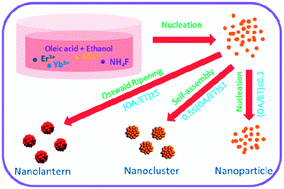The single-band red upconversion luminescence from morphology and size controllable Er3+/Yb3+ doped MnF2 nanostructures†
Abstract
Er3+/Yb3+ doped MnF2 nanostructures have been prepared via a solvothermal method. The morphology of the nanocrystals could be well controlled from nanoparticles to nanoclusters and nanolanterns by varying the volume ratio between oleic acid and ethanol in the solvent. Moreover, the size is tuned from 200 nm to 1.5 μm with the increase of reaction temperature from 110 to 200 °C. It is shown that controlling the doping concentration (Yb3+ ≤ 20 mol%) is essential to preserve the single phase and morphology of the MnF2 host. Single-band red upconversion (UC) emission can be generated in Er3+ single and Er3+/Yb3+ codoped MnF2 nanoclusters due to the energy transfer between host Mn2+ and dopant Er3+ ions. The detailed studies suggest that our MnF2:Er3+/Yb3+ nanocrystals have the strongest single-band luminescence feature at the dopant concentrations of Er3+ (2 mol%) and Yb3+ (20 mol%). The brighter red emission from the current nanostructure compared with those from NaYF4:Er3+/Yb3+ has shown its suitability as an efficient UC luminescence host. It is expected that the achieved intense pure red emission may have potential application in in vivo bioimaging.


 Please wait while we load your content...
Please wait while we load your content...